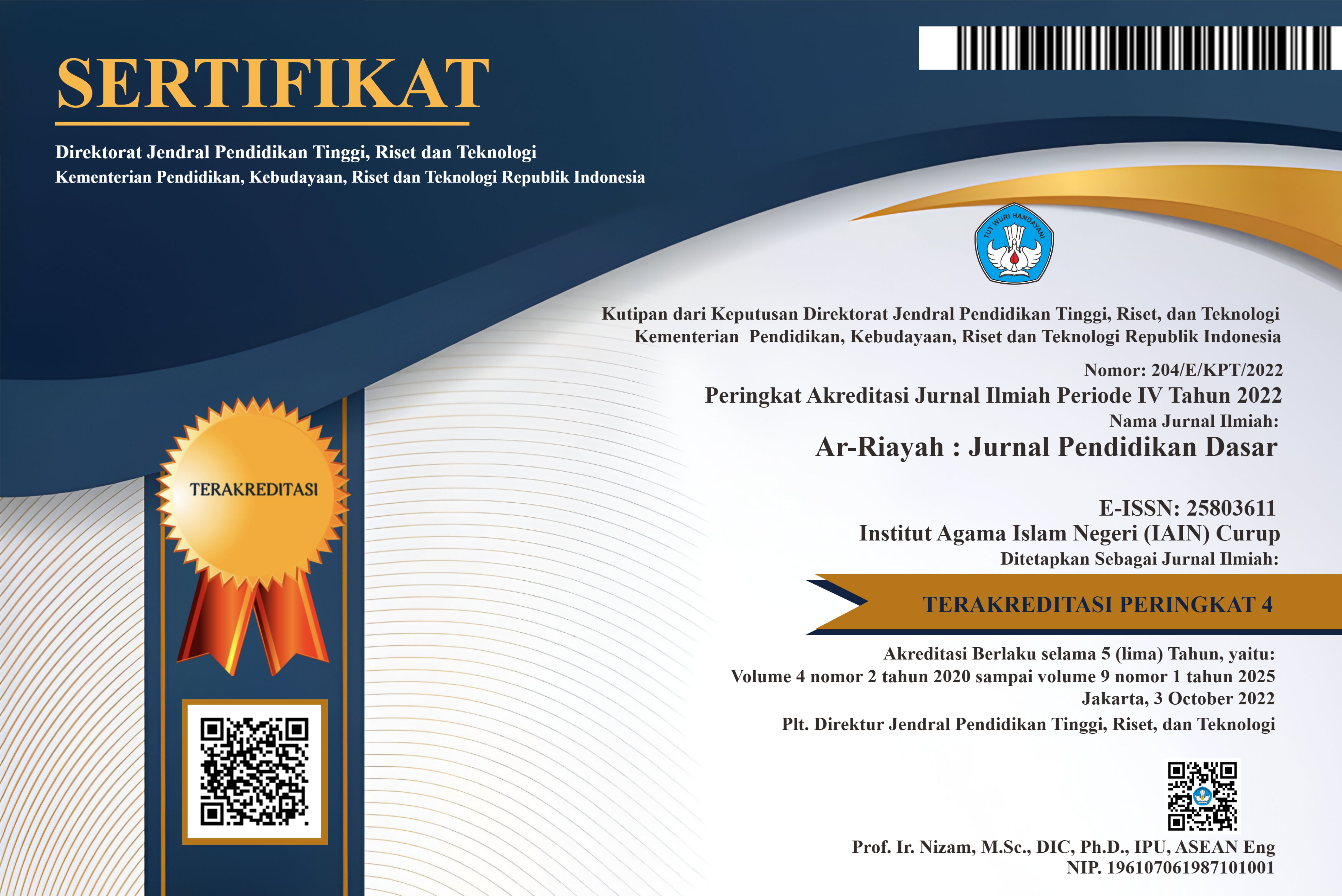Peningkatan Motivasi Belajar dan Kemampuan Berpikir Kritis Peserta Didik Menggunakan Model Think Pair Share Berbantuan Alat Peraga Bahan Bekas
DOI:
https://doi.org/10.29240/jpd.v3i2.1186Keywords:
Learning motivation, Critical thinking, learning model, think pair share, Used materialsAbstract
Downloads
References
Alfianti Naimah. 2017. Penerapan Model Kooperatif Tipe Think Pair Share Dalam Peningkatan Hasil Belajar Ipa Kelas V Sd, Volume 1, Nomer 1. Issn 2549-998x.
Aris Shoimin. 2013. 68 Model Pembelajaran Inovatif Dan Kurikulum 2013. Yogyakarta: Ar- Ruzz Media.
Desmita. 2014. Psikologi Pengembangan Peserta Didik. Bandung: PT Remaja Rosdakarya.
Erika Puspita, Punaji Setyosari, Amirudin. 2016. Peningkatan Motivasi dan Hasil Belajar Melalui Think Pair Share di sekolah Dasar. Teori Pendidikan dan Pengembangan. Volume: 1 Nomer 7.
Hamzah B. Uno. 2013. Teori Motivasi Dan Pengukurannya. Jakarta: Bumi Aksara.
Kompri. 2016. Motivasi pembelajaran perspektif guru dan siswa. Bandung: PT Remaja Rosda karya.
Kisyani-Laksono, Tatag Yuli Eko Siswanto. 2018. Penelitian Tindakan Kelas. Bandung: Remaja Rosdakarya.
Kunandar. 2016. Langkah Mudah Penelitian Tindakan Kelas Sebagai Pengembangan Profesi Guru. Jakarta: Rajawali.
Miftahul Huda. 2017. Model-Model Pengajaran dan Pembelajaran. Yogyakarta: Pustaka Pelajar
Riduwan. 2016. Dasar-Dasar Statistika. Bandung: Alfabeta.
Sardiman. 2016. Interaks dan Motivasi Belajar Mengajar. Jakarta: Raja Grafindo.
Siti Anisatun Nafi’ah. 2018. Model-Model Pembelajaran Bahasa Indonesia Di Sd/Mi, Yogyakarta, Ar-Ruzz Media.
Sochibin, Dwijananti. 2013. Penerapan Model Pembelajaran Inkuiri Terpimpin Untuk Meningkatkan Pemahaman Dan Berpikir Kritis Siswa SD, Jurnal Pendidikan Fisika Indonesia 5. 2013, Issn: 1693-1246.
Sri Purwati. 2015. Meningkatkan Kemampuan Komunikasi Dan Berpikir Kritis Matamatis Siswa Seklah Dasar Dengan Model Missouri Mathematics Project (Mmp),Terampil, Jurnal Pendidikan Pembelajaran Dasar. Volume 2 Nomer 2. P-Issn 2355-1925.
Sugiyono. 2018. Metode Penelitian Kuantitatif, Kualitatif,dan R&D. Bandung: Alfabeta.
Tasiwan, Nugroho, Hartono. 2014. Analisis Tingkat Motivasi Siswa Dalam Pembelajaran IPA Model Advance Organizer Berbasis Proyek, Jurnal Pendidikan IPA Indonesia, Jpii 3 (1).
Yudi Budianti. 2018. Meningkatkan Kemampuan Berpikir Kritis Dengan menggunakan Model Cooperative Tipe Group Investigation Pada Siswa Kelas V Sd Negeri Harapan Jaya 1 Bekasi Utara. Pedagogik Vol. VI, No.1.
Downloads
Published
How to Cite
Issue
Section
Citation Check
License
Authors who publish with Ar-Riayah: Jurnal Pendidikan Dasar agree to the following terms:
Authors retain copyright and grant the journal right of first publication with the work simultaneously licensed under a Creative Commons Attribution-NonCommercial-ShareAlike 4.0 International License (CC BY-NC-SA 4.0) that allows others to share the work with an acknowledgment of the work's authorship and initial publication in this journal.
Authors are able to enter into separate, additional contractual arrangements for the non-exclusive distribution of the journal's published version of the work (e.g., post it to an institutional repository or publish it in a book), with an acknowledgment of its initial publication in this journal.
- Authors are permitted and encouraged to post their work online (e.g., in institutional repositories or on their website) prior to and during the submission process, as it can lead to productive exchanges, as well as earlier and greater citation of published work (See The Effect of Open Access).










